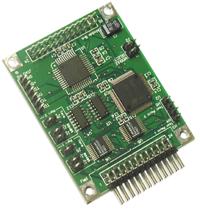UART Wildcard™
Add serial peripherals to your instrumentation or automation project

- Two full-duplex serial ports each capable of simultaneous transmission and reception
- RS232, RS422, and RS485 protocols
- Standard baud rates up to 56000 baud
- Dual 16-byte FIFO (first-in/first-out) buffers on each port
- Optional handshaking signals enable a modem connection for remote communications via any phone line
- Precoded communications software
Communicate with serial peripherals
The UART Wildcard™ implements two full-duplex serial ports that can be configured for RS232, RS422, and RS485 protocols with data rates up to 56000 baud. Optional handshaking signals enable a modem connection for remote communications via any phone line. Dual 16-byte FIFO (first-in/first-out) buffers on each port reduce processor overhead when sending and receiving serial data streams.
This tiny 2" by 2.5" board is a member of the Wildcard series of mezzanine boards that connect to Mosaic embedded computers and instrument controllers.
UART Basics
A "UART" is a "Universal Asynchronous Receiver/Transmitter" that converts parallel data from the host processor (any Mosaic controller) into a serial data stream. This Wildcard uses the industry standard 16C552 dual UART chip. Each of the two UARTs is capable of "full duplex" communications, meaning that both transmission and reception can occur simultaneously.
Pre-coded software and easy configuration
Pre-coded software lets you specify the number of start bits, data bits, and stop bits, baud rate, parity, and communications protocol for each port. The software makes it easy to revector the standard serial I/O print and scan functions to use a specified serial port on the UART Wildcard.
Software-selectable baud rates up to 56,000 baud are supported. Standard attainable baud rates are 300, 1200, 2400, 4800, 9600, 19200, 38400 and 56000 baud. Parity options include even, odd, high, low, or no parity. Data format options include 5 to 8 bits per character and 1 to 2 stop bits. Each of the two serial ports can be configured for RS232, RS422, or RS485 communications. All of the serial interface signals are brought out to a 24 pin field header.
The serial data stream at the UART is conditioned by serial driver chips that transmit and receive the data. The resulting signal levels on the interface cable connect the local and remote in a manner specified by a standard protocol. The most widely used protocol is RS232, a full duplex protocol with a single-ended bipolar voltage swing on the serial cable. The UART Wildcard also implements the full duplex RS422 and the half duplex multi-drop RS485 protocols, each of which drives differential 0 to 5 volt signals on the serial cable. Optional jumper-selectable termination networks can be inserted at the RS422 and RS485 receivers to improve signal fidelity.
Mark and space parity of uart
Serial data is shifted out least-significant-bit first. At the UART, a logic high (5 volts) is called a "mark", and a logic low (0 volts) is called a "space". The serial output at the UART idles at the logic high (mark) level. A logic-low "start bit" marks the start of a character, followed by 5 to 8 data bits per character. An optional "parity" bit can be specified to enable error detection by the UART. One to two logic-high "stop bits" mark the end of a character. Even parity means that the bits sum to an even number, and odd parity means that the bits sum to an odd number. High (mark) parity means that the parity bit is always logic 1 at the UART, and low (space) parity means that the parity bit is always logic 0 at the UART. No parity means that there is no parity bit. Both the local and remote UARTs must be configured for the same communications parameters. The standard data format for the Mosaic product line is 8 data bits, no parity, and 1 stop bit.
Optional modem connections
Serial port 1 can be configured to support an RS232 modem interface with the handshaking signals DTR, DSR, RTS, CTS, and DCD (data carrier detect). If the modem option is enabled, then serial port 2 must be configured for either RS422 or RS485 communications.





